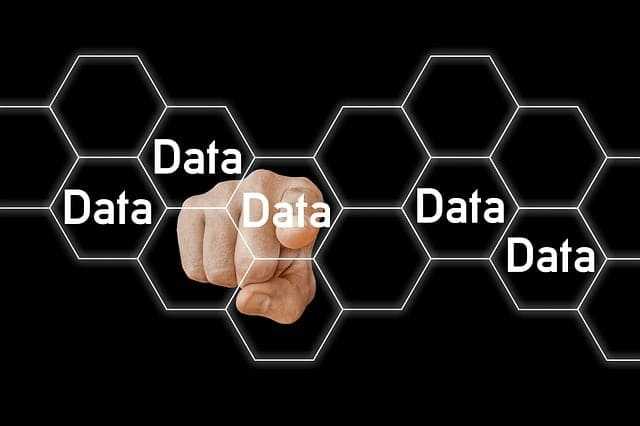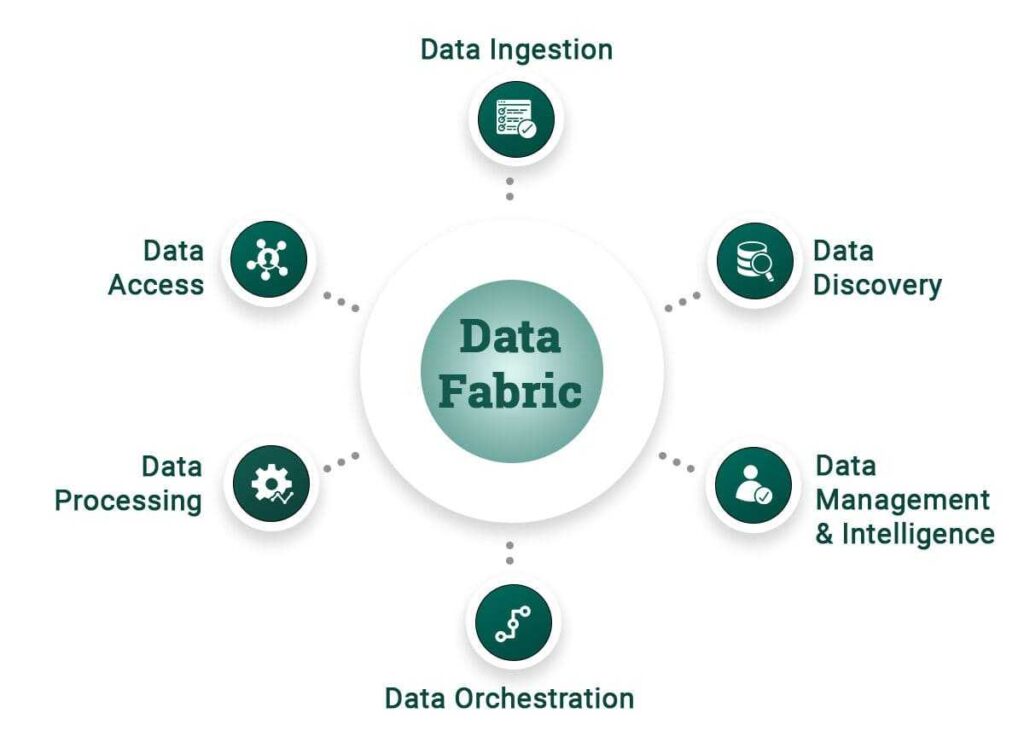In ever evolving panorama of employer statistics control brand new paradigm has emerged.. that promises to revolutionize how organizations take care of their maximum precious asset: facts. This paradigm called Data Fabric is swiftly gaining traction amongst forward wondering groups and IT experts. As quantity range & speed of records continue to grow exponentially conventional statistics management strategies are suffering to maintain tempo. Data Fabric offers technique to these challenges providing unified sensible & flexible method to statistics control.. that spans throughout various environments and allows seamless data get entry to integration & governance.
Understanding Data Fabric : At its center Data Fabric is an architectural method to statistics control.. that weaves together information from disparate resources locations & codecs right into cohesive and unified facts atmosphere. It creates layer of connectivity.. that spans throughout on premises multi cloud & facet environments allowing corporations to manage and utilize their information assets extra successfully and efficiently.
The concept of Data Fabric goes past conventional statistics integration strategies. Its not pretty much transferring information from one vicinity to another or growing centralized statistics repository. Instead Data Fabric creates dynamic sensible community of information offerings which can adapt to converting business needs and technological landscapes.
One of key characteristics of Data Fabric is its potential to offer consistent statistics management enjoy throughout heterogeneous environments. Whether your records is living in legacy on premises systems cutting edge cloud systems or facet devices Data Fabric creates unified layer.. that abstracts away underlying complexities presenting customers with seamless interface for data get right of entry to and manipulation.
Another vital element of Data Fabric is its emphasis on metadata. By leveraging advanced metadata control abilties Data Fabric can provide deep insights into character lineage & usage patterns of records. This metadata pushed approach permits sensible automation of diverse facts management responsibilities from records discovery and integration to governance and safety.

Building Blocks of Data Fabric
To fully hold close concept of Data Fabric it is vital to understand its key additives and way they work collectively to create cohesive statistics control surroundings.
Data Integration
At coronary heart of Data Fabric lies robust records integration talents. This involves now not simply conventional extract remodel & load (ETL) procedures but also real time records streaming API based totally integration & event driven architectures. Data Fabric enables companies to seamlessly integrate information from numerous resources regardless of their layout or region.
The integration layer of Data Fabric is designed to be pretty flexible and adaptable. It can manage based semi established & unstructured records & can without difficulty include new records assets as they emerge. This flexibility is vital in modern swiftly converting records panorama wherein new statistics kinds and sources are constantly emerging.
Data Virtualization
Data virtualization is any other important component of Data Fabric. It permits customers to access and manage statistics without needing to recognize its physical vicinity or format. By creating virtual layer.. that abstracts underlying information infrastructure Data Fabric allows users to work with records as if it were in single unified system.
This virtualization functionality is in particular precious in complex heterogeneous data environments. It permits companies to leave facts in its original vicinity even as nonetheless providing unified view and get right of entry to point. This can notably reduce want for facts motion and replication main to cost savings and advanced information freshness.

Metadata Management
Metadata management is spine of Data Fabrics intelligence. By capturing storing & analyzing metadata approximately records assets Data Fabric can provide deep insights into character and utilization of records throughout organization.
This metadata layer goes past simple records cataloging. It includes statistics about statistics lineage records great utilization patterns & relationships among one of kind information belongings. This rich metadata enables advanced capabilities which include computerized facts discovery sensible facts integration & context conscious information governance.
Data Governance and Security
Data Fabric carries sturdy records governance and security skills. This guarantees.. that records isnt simplest reachable but also nicely blanketed and utilized in compliance with applicable rules and organizational regulations.
The governance layer of Data Fabric usually includes capabilities which includes facts access control information overlaying encryption & audit logging. It additionally presents equipment for outlining and imposing data regulations across complete facts ecosystem.

AI and Machine Learning
Artificial Intelligence (AI) and Machine Learning (ML) play vital function in making Data Fabric genuinely sensible and adaptive. These technologies are leveraged in various aspects of Data Fabric from automating records integration processes to providing advanced analytics abilities.
AI and ML algorithms can examine metadata and usage styles to indicate most effective statistics integration strategies are expecting facts nice troubles & even automate positive aspects of statistics governance. This infusion of intelligence makes Data Fabric self studying self optimizing device.. that continually improves its overall performance over years.
Benefits of Data Fabric
The adoption of Data Fabric structure can deliver severa advantages to agencies no matter their length or industry. Lets discover some of important thing blessings:
Enhanced Data Accessibility
One of number one advantages of Data Fabric is advanced statistics accessibility. By creating unified statistics layer.. that spans across numerous environments Data Fabric enables customers to get entry to records they want once they need it irrespective of wherein it resides. This more advantageous accessibility can lead to quicker selection making and advanced operational performance.
Moreover Data Fabrics virtualization abilities imply.. that customers can work with information without needing to recognize complexities of underlying statistics infrastructure. This democratization of statistics get entry to can empower wider variety of customers within agency to leverage information in their day to day work.

Improved Data Quality and Consistency
Data Fabrics emphasis on metadata management and facts governance can substantially enhance statistics best and consistency across corporation. By imparting comprehensive view of information lineage and relationships Data Fabric makes it less difficult to become aware of and clear up facts nice issues.
Furthermore centralized governance competencies of Data Fabric make sure.. that facts rules are continually applied across all facts belongings no matter their area. This can assist in retaining records integrity and compliance with regulatory necessities.
Increased Agility and Flexibility
In state of art fast paced business surroundings capability to quick adapt to changing information wishes is essential. Data Fabric presents ability and agility had to reply to those modifications effectively.
Whether it is integrating brand new statistics source enforcing brand new analytics use case or adapting to new regulatory requirements Data Fabrics modular and adaptable architecture permits agencies to make those modifications fast and with minimal disruption.
Cost Optimization
While implementing Data Fabric can also require initial investment it can result in vast value financial savings ultimately. By decreasing need for facts movement and replication Data Fabric can lower storage and computational expenses.
Moreover automation talents of Data Fabric can reduce manual effort required for numerous facts control tasks main to operational value financial savings. stepped forward data high quality and accessibility also can indirectly make contributions to price savings via allowing extra efficient and powerful commercial enterprise operations.
Enhanced Analytics and AI Capabilities
Data Fabric can appreciably improve an corporations analytics and AI capabilities. By presenting clean get entry to to extensive range of statistics assets and ensuring facts exceptional Data Fabric creates strong foundation for superior analytics and AI initiatives.
The unified facts layer created by means of Data Fabric makes it simpler to combine various datasets for complicated analyses. Furthermore rich metadata captured by means of Data Fabric can offer precious context for AI fashions probably enhancing their accuracy and effectiveness.
Implementing Data Fabric: Challenges and Best Practices
While advantages of Data Fabric are compelling imposing this architecture isnt always without challenges. Here are few key issues and exceptional practices for corporations seeking to undertake Data Fabric:

Start with Clear Strategy
Before diving into implementation it is essential to have clear approach and vision on your Data Fabric initiative. This should align with your overall commercial enterprise goals and records method. Consider questions together with: What are primary use instances you need to address? What are your key records sources and purchasers? What are your important records management pain points?
Having clear approach will assist you prioritize your efforts and make sure.. that your Data Fabric implementation grants tangible business fee.
Focus on Metadata
Metadata is muse of Data Fabrics intelligence. Invest time and resources in growing comprehensive metadata management method. This must include not just technical metadata but additionally commercial enterprise metadata.. that offers context about.. that means and usage of records assets.
Consider enforcing automatic metadata discovery and management gear to reduce manual attempt worried in retaining metadata. Also make certain.. that your metadata method consists of plans for ongoing metadata exceptional guarantee and governance.
Embrace Incremental Implementation
Implementing Data Fabric doesnt should be an all or not anything proposition. In fact phased incremental approach is regularly extra success. Start with specific use case or information domain put into effect Data Fabric abilties for.. that location & then gradually amplify to different regions.
This method lets in you to illustrate cost fast research from early studies & refine your technique as you pass. It also helps in managing organizational alternate.. that regularly accompanies such substantial shift in records control technique.
Invest in Skills and Culture
Successful Data Fabric implementation requires now not just technological change however additionally shifts in abilties and organizational lifestyle. Invest in training and development packages to ensure.. that your crew has essential abilities to work with Data Fabric technologies.
Moreover foster statistics driven way of life.. that values records as strategic asset. Encourage move functional collaboration and facts sharing & promote records literacy throughout organisation.

Prioritize Data Governance
While Data Fabric can enhance statistics accessibility its vital to stability this with strong information governance. Implement robust facts get right of entry to controls encryption & auditing mechanisms to ensure.. that information is used responsibly and in compliance with relevant policies.
Develop clean information governance rules and ensure.. that theyre consistently carried out throughout your complete data environment. Consider imposing automatic coverage enforcement mechanisms to reduce weight for your records governance group.
Choose Right Tools and Technologies
The era landscape for Data Fabric is swiftly evolving with many providers providing Data Fabric answers. When deciding on tools and technology recollect elements which includes:
Compatibility together with your present information infrastructure Scalability to deal with your modern and future statistics volumes Flexibility to evolve to changing records desires Ease of use for both technical and business users Robustness of metadata control and governance capabilities
Remember.. that Data Fabric is an architectural approach no longer single product. You may want to combine couple of gear and technologies to create comprehensive Data Fabric answer.
Future of Data Fabric
As we appearance to destiny several tendencies are possibly to shape evolution of Data Fabric:
Edge Computing Integration
With rise of Internet of Things (IoT) and part computing destiny Data Fabric architectures will want to seamlessly integrate facet information resources and processing talents. This will permit actual time data processing and analytics at brink at same time as nevertheless retaining unified view of facts throughout complete surroundings.
Enhanced AI and Automation
AI and machine learning capabilities within Data Fabric are in all likelihood to come to be extra sophisticated. We can count on to peer more superior automation of statistics control obligations predictive records first class management & AI driven statistics governance.
Semantic Data Fabric
The idea of Semantic Data Fabric which provides layer of which means and context to information is gaining traction. This technique makes use of know how graphs and ontologies to create semantic layer.. that complements facts knowledge and interoperability.
Data Mesh Integration
While Data Fabric and Data Mesh are often seen as competing concepts theyre probable to converge inside future. We can also see Data Fabric architectures.. that incorporate concepts of Data Mesh together with domain oriented decentralized statistics ownership and self serve data infrastructure.
Expanded Data Ecosystem
Future Data Fabric architectures will possibly enlarge to encompass wider range of statistics resources and consumers. This ought to consist of external data marketplaces companion ecosystems & even public information resources growing extra comprehensive and interconnected facts landscape.
Data Fabric represents good sized evolution in company statistics management. By imparting unified wise & flexible method to records management it addresses many of challenges corporations face in present day complex and diverse statistics environments.
While enforcing Data Fabric can be challenging capability advantages from advanced information accessibility and first class to better analytics abilities and improved agility make it compelling option for organizations trying to maximize price of their facts belongings.
As we flow into an an increasing number of records driven destiny Data Fabric is in all likelihood to play vital role in supporting organizations navigate complexities of modern day information landscapes. By supplying solid basis for statistics management Data Fabric permits businesses to not just maintain pace with facts revolution but to lead it using innovation and competitive advantage through power of information.